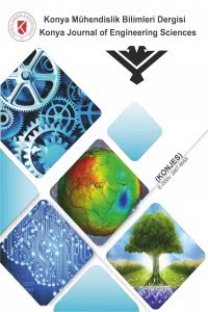Effect of different wall functions on the prediction of flow and heat transfer characteristics in plate fin and tube heat exchangers
Kanat-borulu ısı eşanjörlerinin akım ve ısı transfer özelliklerinin belirlenmesinde farklı duvar fonksiyonlarının etkisi
___
- Barsamian, H.R., Hassan, Y.A., 1997, Large Eddy simulation of turbulent crossflow in tube bundles, Nucl. Eng. Des., 172,103-122.
- Critoph, R.E., Holland, M.K., Fisher, M., 1999, Comparison of steady state and trasnsient methods for measurement of local heat transfer in plate fin-tube heat exchangers using liquid cristal thermography with radiant heating, Int. J. Heat Mass. Tran., 42, 1-12.
- FLUENT DYNAMICS SOFTWARE, 1998, FLUENT (Ver. 5.5).
- Goldstein, L.G., Sparrow, E.M., 1976, Experiments on the transfer characteristics of a corrugated fin and tube heat exchanger configuration, J. Heat. Trans.-T. ASME, 98, Feb., 26-34.
- Kim, N.H., Yun, J.H., Webb, R.L., 1997, Heat transfer and friction correlations for wavy plate fin- and- tube heat exchangers, Transactions of the ASME, 119, 560-567.
- Kundu, D., Skeikh, A.H., Lou, D.Y.S., 1992, Heat transfer in crossflow over cylinders between two parallel plates, Numer. Heat Tr. A-Appl, 114, 558-564.
- Lozza, G., Merlo, U., 2001, An experimental investigation of heat transfer and friction losses of interrupted and wavy fins for fin-and-tube heat exchangers, Int. J. Refrig., 24, 409-416.
- Madi, M.A., Johns,R..A.,Heikal, M.R., 1998, Performance characteristics correlation for round tube and plate finned heat exchangers, Int. J. Refrig., 21, 7, 507-517.
- Mendez, R.R., Sen, M., Yang, K.T., Mcclain, R., 2000. Effect of fin spacing on convection in a plate fin and tube heat exchanger, Int. J. Heat Mass. Tran., 43, 39-51.
- Rocha, L.A.O., Saboya, F.E.M., Vargas, J.V.C., 1997, A comparative study of elliptical and circular sections in one- and two- row tubes and plate fin heat exchangers, Int. J. Heat Fluid Fl., 18,247-252.
- Saboya, F.E.M., Sparrow, E.M., 1974, Local and average transfer coefficients for one row plate fin and tube heat exchanger configurations. J. Heat Transfer, Trans. ASME., August: 265-272.
- Seshimo, Y., Fujii, M., 1991, An experimental study on the performance of plate fin and tube heat exchangers at low Reynolds Numbers, ASME/JSME Thermal Engineering Proceedings, 4, 449- 454.
- Shah, R.K., Heikal, M.R., Thonon, B., 1997, Advances in numerical analysis of fluid flow, heat transfer, and flow friction characteristics of compact heat exchanger surfaces, Proceedings, Int. Symposium on Fluid Flow and Heat Transfer, Ankara, Turkey, 68-87.
- Tzanetakis, N., Scott, K., Taama, W.M., Jachuck, R.J.J., 2004. Mass transfer characteristics of corrugated surfaces, Appl. Therm. Eng., 24,13,1865-1875.
- Valencia, A., Fiebig, M., Mitra, N.K., 1996, Heat transfer enhancement by longitudinal vortices in a fin-tube heat exchanger element with flat tubes, J. Heat Trans., 118, 209-211.
- Wang, C.C., Fu, W.L., Chang, C.T., 1997, Heat transfer and friction characteristics of typical wavy fin- and- tube heat exchangers, Exp. Therm. Fluid Sci., 14,174-186.
- Wung, T.S., Chen, C.J., 1989, Finite analytic solution of convective heat transfer for tube arrays in crossflow: Part I- Flow field analysis, J. Heat Trans., Ill, 633-640.
- Yan, W.M., Sheen, P.J., 2000, Heat transfer and friction characteristics of fin and tube heat exchangers, Int. J. Heat Mass Trans., 43,1651-1659.
- Zhang, J., Kundu, J., Manglik, R.M., 2004, Effect of fin waviness and spacing on the lateral vortex structure and laminar heat transfer in wavy-plate-fin cores, Int. J. Heat Mass Trans., 47, 1719- 1730.
- ISSN: 1300-5200
- Yayın Aralığı: 4
- Başlangıç: 2018
- Yayıncı: -
S.Ü. kampüs atıksularının karakterizasyonu ve su merceği (Lemna Minor L.) ile arıtılabilirliği
Zehra YILMAZ, Kemal GÜR, Esra TARLAN
Rotari sondaj yöntemi ile karbondioksit (CO2) gazının çıkarılma işlemleri ve karşılaşılan problemler
M. Gürhan YALÇIN, Zeynep ŞAHİN
Serbest ortamda lazer ile optiksel iletişim sistemleri için bilgisayar simülasyonu
Konya yeraltısuyunda dezenfeksiyon yan ürünleri
MEHMET EMİN AYDIN, Ali TOR, GÜLNİHAL KARA, Süheyla YILDIZ
Azize AKKOCA, Beşir ŞAHİN, Mustafa TUTAR
Elazığ kenti atıksu arıtma tesisinin koliform bakteri giderme veriminin araştırılması
Ortoamfibolit ve metagabroların petrolojik ilişkileri: Himmetli köyü kuzeyi (Niğde)
Hüseyin KURT, Kerim KOÇAK, Kürşat ASAN, Yusuf Kağan KADIOĞLU, Mustafa KARAKAŞ
Andızlık- Zımparalık (Muğla) civarındaki kromitlerin ve bazik daykların kökeni
